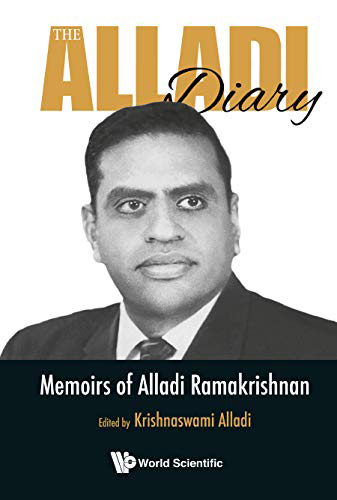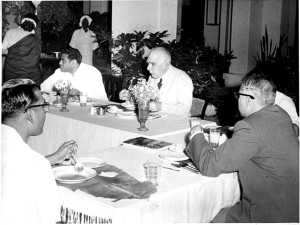Registered with the Registrar of Newspapers for India under R.N.I 53640/91
Vol. XXIX No. 4, June 1-15, 2019
The Alladi Diary
by Vijaysree Venkatraman

On a balmy winter’s day in 1954, Paul Dirac a Nobel Laureate in physics gave a general lecture at the Senate House in the University of Madras. The hall was packed. Outside, people sat in their cars, as if they were at a drive-in cinema, to catch the man’s words. It is hard to know what the majority of the listeners made of it all. There was, however, no mistaking their avidity for the latest from the world of science.
Alladi Ramakrishnan (1923-2008), who was a young reader at the University of Madras at the time, began inviting other world-class scientists to the city to address his students after this inaugural lecture. As a student in the U.K, he had built a good reputation for himself through his work. So international researchers, who were passing through India were happy to oblige this newly-minted professor. They too invited him to attend conferences abroad. After a stint at the renowned Institute for Advanced Study in Princeton, he decided to create a similar center in India.
Back then, theoretical physicists, like mathematicians, didn’t need laboratory equipment or computers to work with, so a lack of funds in a newly-independent India was not a huge handicap but there were other formidable obstacles. How Ramakrishnan established the Institute of Mathematical Sciences (popularly, Matscience) in 1962 despite all odds is at the heart of his enjoyable memoir. A new edition of The Alladi Diary was recently published by the World Scientific Press. It released earlier this month at Matscience.

Nobel Laureate Niels Bohr at a South Indian Style dinner (served on a plantain leaf) hosted by Alladi Ramakrishnan at Ekamra Nivas, Jan 1960.
Thanks to this audacious dreamer, today we have a world-class homegrown institute for theoretical physics and allied disciplines at Taramani. It all began with the seminars, which Ramakrishnan participated in at Princeton. He describes it as “the essence of intellectual activity, where there is as much desire to imbibe as there is to impart, where opportunities are provided for a clash of intellects which would produce creative ideas.” Convincing the university authorities of the need for such “out-of-syllabus” interactions was tough. Luckily Ramakrishnan’s father, a legal luminary, owned a huge garden home in Mylapore. The stately Ekamra Nivas on Luz Church Road was the venue for a series of seminars.
No doubt, this scientist has a great life story to tell and tells it with flair. Ramakrishnan’s father Sir Alladi Krishnaswami Aiyar, was the Advocate General of Madras, later working with B.R. Ambedkar to draft India’s constitution. Among the famous visitors to Ekamra Nivas was Sir. C.V. Raman, Asia’s first Nobel laureate in physics. The lawyer mentioned his son’s interest in physics to Raman but nothing came of it. Ramakrishnan, who earned a law degree, accompanied his father to the capital as an apprentice to help with the important work of drafting the constitution. There, at a state dinner, he met Homi Jahangir Bhabha. The nuclear physicist from Bombay inspired the young lawyer to change course, and make a name for himself in a different field.
We also catch glimpses of life in an upper class household like Ekamra Nivas and the people needed to run the place. The dhobi who collected dirty linen and brought it back “white as snow, but in various stages of damage after boiling them in cauldrons near Red Hills where the water was plentiful.” The cook who accompanied the lawyer on outstation trips could reputedly whip up excellent meals in the horse carriage, or a train compartment, with just a few judiciously chosen ingredients. This “jhutka cook” later trained the staff at home to make traditional dishes with the usual “karam,” and a milder version without chilies for the western palate. (Dirac, apparently chose the karam version when he dined there.)
When Ramakrishnan, the impeccable host, invited scientists over, he talked about his hometown as a place worth visiting. “With pardonable vanity of a citizen of Madras, I can assure you that we can make your visit quite interesting since Madras still preserves some strains of Hindu culture and ways of life despite the rapid onset of industrialisation,” he writes to Niels Bohr, father of modern physics, in 1959. An excursion to Mahabalipuram was a standard fixture for visitors. The scene of the raptors showing up for their daily feeding at a hill top temple in Thirukalikundram was something to delight in. Sometimes, there were picnics under the mango trees near his ancestral village. There were dance dramas at Kalakshetra; concerts at home led by Lalitha, his wife, a trained Carnatic vocalist.
Of course, the legendary mathematician Paul Erdös (1913-1996), who crisscrossed continents to work on mathematical problems with colleagues, came to Ekamra Nivas too. As an undergraduate, Ramakrishnan’s son, Alladi Krishnaswami, had contacted the itinerant Hungarian mathematician regarding a problem in number theory. The man whose biography is titled The Man Who Loved Only Numbers loved to discover and work with fresh talent. He met Krishnaswami and encouraged him to pursue research with a professor at the University of California in Los Angeles. Erdös donated the honorarium he received from Matscience to the Governor of Tamil Nadu’s special education fund, just as he gave away most of his earnings to various good causes all through his life. Krishnaswami, who went on to co-author a paper with Erdös, is now a mathematics professor at the University of Florida. He has edited his father’s diary, and added footnotes, photographs, and copies of carefully-preserved letters for this new edition of the memoir.
After serving as the director of Matscience for twenty-one years, Ramakrishnan retired, but remained productive in research for the next quarter century. Staying in Florida with his son for substantial periods of time and attending conferences at universities abroad, gave him many opportunities to work with younger mathematical minds. Unlike Erdös, he had a variety of interests – Carnatic music, cricket and tennis among them – and loved spending time with his family. In India, he was a sought-after speaker and, encouraged young people to pursue a career in research.
Despite Ramakrishnan’s interest in communicating science, few in the city know where Matscience is located or what happens at that campus. Recently, the institute has begun to make outreach attempts with its annual lecture event called “Science in the Sabha.” At the Music Academy, scientists from math-related fields address a general audience and speak to them about their research. Most encouragingly, there are always a good number of school students in the audience. They ask questions at the end of the talks, so it is fair to assume that they’ve not been dragged there on a Sunday evening by over-zealous parents.
Hopefully, students at the school and college level will flip through the new edition of The Alladi Diary with interest. This account of science history in Madras could help ensure that excellence in mathematical sciences doesn’t become a thing of the past. It will remind readers of what was, and what is still possible here in the realm of advanced physics and mathematics. There are theorems to be proved, problems to be solved, quantum computers to be built in the 21st Century.

